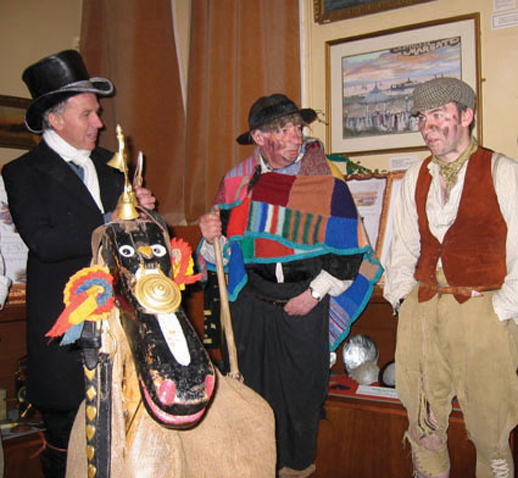
by Becky Stewart.
This year I got my first taste of a truly traditional Thanet Christmas – A Hoodening! An ancient pagan custom marking the winter solstice that dates back many centuries and whose definitive meaning is so lost in time no one will ever know it’s true origin. Many theories abound. Even at the turn of the 19th Century this was a dying custom but luckily, local historian Percy Maylam recorded an in depth study of it in his book The Kent Hooden Horse which has recently been republished after 100 years of it being out of print.
My personal obsession with ‘animal disguise rituals’ started with an accidental late night viewing of The Wicker Man when I was about 10 years old. Apart from the obvious abomination in basketry, the hobby horse – chasing poor Edward Woodward through the twisty lanes snapping its jaws, terrified me. I’m not sure why ‘disguised’ as an animal – especially one so roughly hewn and unrealistic – is quite so alarming. But I do know I’m not the only one that finds them downright sinister.
There are many ancient British customs involving a human dressed as a horse, the most famous being the Padstow Obby Oss but the ‘Hooden Horse’ is of a particular design and was confined to East Kent only. The head is carved from wood and is adorned with bells and rosettes to signify he is ‘the best horse’. The mouth is opened and closed with a string making a loud crack as the hobnails that comprise its teeth are snapped together. The head is on a wooden pole, which is held on to and moved around by the occupant to surprisingly unnerving effect. The covering is made of an old hop sack.
I’d never heard of this custom till moving to the area and then it was only by online browsing of books on local history that I came across it. I was most excited to see that one group do still perform every year around Christmas with their horse ‘Dobbin’, thought to be over 200 years old. Apart from a sabbatical from the 1930s to the mid 60s, he’s been gainfully employed the whole time. Terrorising the local community – mostly in Thanet pubs, farms and ‘big houses’ – around Christmas time. He can be seen in the pictures included in Maylam’s book in his middle years. There are apparently a lot of these ‘poor old horses’ as they’re sometimes known still around but mostly residing in museums and even then rarely on display.
And so to The East Kent Hoodeners who are a group from St Nicholas at Wade, a tiny farming village in Thanet. Including Dobbin, the cast has 6 characters – Waggoner Bill who wears a top hat, carries a whip and keeps the others in line, Mollie – A middle aged woman played by a man who carries a broom, Sam the farm labourer, lazy mean and smelly, Boy – young and reckless, tries to ride the horse sometimes with little success and the Musician,
George. He plays the fiddle for the musical finale and wears a bizarre suit made of old floral curtains. All costumes are authentic as worn in Victorian times as early photos indicate. The play, is told in rhyming verse and though basically the same recurring themes of death and resurrection (within the context of a group of 19th Century farm workers), are played out each year, a new play is written to include topical jokes from the past years events, both local and national. This along with absurd cross dressing, heaps of innuendo and so on. Very funny and very British. Typical panto fayre done in a somewhat under rehearsed fashion which all adds to the charm. Especially after a few ales! Even jokes about Benton and Polarbeargate made it in there this year.
Back in the day these roles were played by real farm workers. With little to do in the winter months, entertaining the locals with their performances was a great way to raise money for themselves. Sometimes the horse did get a bit out of line though. I believe this tradition is still banned in Broadstairs where in early Victorian times one young woman actually died of fright when ‘surprised’ by the Horse. Another naughty horse ventured into a kitchen there and snatched a bag of spice from a woman’s hand! The current troupe is an amiable and far more well behaved bunch and they raise money for a chosen charity each year.
Slightly disturbing but all the more fun for it, this is one custom that I hope never disappears completely. Ideally I’d like to see more of these horses come out of retirement and roam the mean streets of Thanet once again. It’s a fascinating tradition and something East Kent should be proud of yet sadly – does nothing to promote. However, right now there is a small exhibition of East Kent customs in the Margate Museum, which includes Hoodening and Wassailing and is on till February. (Run by volunteers so only open on Saturdays). Dobbin and the boys will be back to entertain anyone prepared to offer them free beer come December.
For more information, historical facts and photos, please check out Ben Jones’ (aka George the Musician) wonderful website.